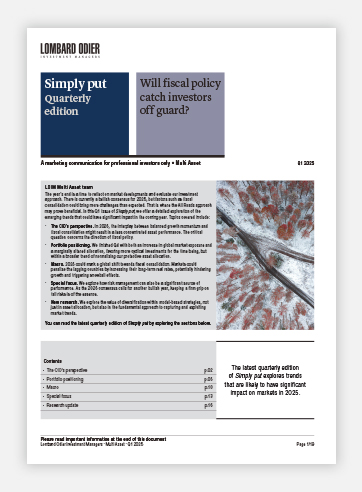 |
Simply put quarterly edition: Will fiscal policy catch investors off guard? |

A central theme for our investment process has been that risk management is not solely about mitigating risks; it can also be a significant source of performance. Our approach has involved eschewing a singular market perspective in favour of seeking diversification and prioritising signal-driven strategies over narrative-driven ones. These principles have consistently enhanced our strategies. In addition, our ability to moderate extreme returns has made a distinct contribution that we anticipate will continue to serve us well in 2025.
In 2024, the prevailing consensus anticipated a year fraught with risks, with rate cuts signalling a profit slowdown and viewing steady growth as a risk itself. Conversely, the outlook for 2025 is more optimistic, albeit tempered by potential fiscal consolidation and political risks. Such factors could precipitate ‘tail events’, which inherently pose a threat to portfolios due to their direct impact on performance and the temptation to reduce exposures and realise losses. Here, we explore how managing extreme events can generate value, as mitigating tail risks does not necessarily equate to diminishing returns.
Scenarios do not drive our investment strategy. We value diversification, both in terms of the investment universe and investment signals, and this has remained our philosophical anchor since we first launched All Roads. This does not preclude us from considering the potential environments that could lead our solutions to outperform or underperform. There is a growing consensus that growth over the next year may improve – a scenario not observed in the past two years, except in the US. This optimistic outlook is currently supported by our set of nowcasters and, as long as these systematic measures of the business cycle remain stable, we will refrain from forecasting a recession.
Read also: A new rate environment: what do higher bond yields mean?
However, this consensus view also prompts us to consider the associated risks, especially tail risks. Fiscal consolidation may impact the economy, interest rates and company profits, casting a shadow of tail risks. Figure 1 illustrates the frequency of tail risk events in the S&P 500 in the year following a specific level of the VIX index. Intuition might suggest that a higher VIX would predict a higher probability of such events, but the data indicates otherwise: a VIX at 20 has led to the same frequency of left-tail extremes as a VIX at 35. A bullish consensus has historically led to as many tail events as a more bearish consensus. Additionally, very low VIX levels do not prevent tail risks; they simply reduce their frequencies: VIX in the 12.5-17.5 region shows about a 0.3% extreme return frequency, and VIX between 17.5 and 20 sees that frequency reach 0.6%. The occurrence of large negative returns, which can trigger significant market declines, has been studied under the concept of the ‘jump-to-volatility channel’, underscoring the importance of dynamic drawdown management1. The question is how our strategies will perform when such extreme events occur.
FIG 1. Frequency of extreme left tail events as a function of the level of the VIX2

This topic is frequently discussed with our clients and prospects around the globe. Figure 2 illustrates the outcomes of investing in the S&P 500 under different scenarios:
This straightforward yet enlightening example underscores how risk management – exercising caution while invested – can add value and enhance the profile of a long-only investment situation. However, it is important to note that this example assumes perfect foresight in selecting the worst days to avoid, which is clearly unrealistic in real life. Our ambition is that risk management will improve risk-adjusted returns, by cutting off the tails of the return distribution. If, in addition, it yields an uptick in performance, even better! Let’s look at how it has performed so far.
FIG 2. Current value of investing one dollar in S&P 500 since 19683

Our dynamic drawdown management has matured over the past 12 years, providing us with invaluable experience, and a growing and meaningful sample to look at. Figure 3 illustrates the performance distribution of our strategy since its inception in 2012 compared to a passive long-only portfolio composed of 40% equities and 60% bonds. Both strategies are scaled so that they have the same full-sample volatility in order to ensure an apples-to-apples comparison.
As the chart clearly shows, both distributions exhibit fat tails, indicating they are influenced by very large values, both negative and positive, at times. Another (formulaic) way to see this is to look at excess kurtosis – the All Roads distribution has a negative excess kurtosis of -0.8 (indicating a tail even flatter than the normal distribution) while the passive 40/60 portfolio has an excess kurtosis of 11.9, indicating a very heavy distribution. In addition, the negative skew, common within long-only portfolios, is substantially reduced in All Roads.
The lower section of the figure zooms in on these tails. These charts distinctly underscore the value of our dynamic risk management: the 40/60 portfolio exhibits six more extreme returns than our strategy, resulting in a non-compounding performance deficit of -17%. Trimming the left tail of returns inevitably leads to the sacrifice of some large positive returns, as mentioned earlier, but their cumulative impact amounts to only 10.3% across four days.
This shows our dynamic risk management has effectively supported the argument we regularly present: by significantly reducing the left tail while capturing a substantial portion of the right tail, our process enhances performance, on a risk-adjusted basis first and foremost but also, in this instance, on an outright performance basis. This approach could be very relevant over the next year as, in our view, the prevailing growth consensus driving the market could yield unexpected setbacks.
FIG 3. Distribution of returns for the 40/60 portfolio in USD and the All Roads strategy rescaled to match the 40/60 volatility (top) and zoom on both tails (below)4

important information.
For professional investors use only
This document is a Corporate Communication for Professional Investors only and is not a marketing communication related to a fund, an investment product or investment services in your country. This document is not intended to provide investment, tax, accounting, professional or legal advice.
Read more.